Message from the CEO
Our aim is to continue growth over the long term by transforming to businesses with high added-value that contribute to solving issues faced by society.
Shoei Yamana
President and CEO
Our aim is to continue growth over the long term by transforming to businesses with high added-value that contribute to solving issues faced by society.
Shoei Yamana
President and CEO

In fiscal 2015, the second year of our Medium Term Business Plan TRANSFORM 2016, revenue increased from the previous fiscal year following increased sales of high-end models for commercial printing, the positive effects of revenue from mergers and acquisitions (M&As), and a stronger dollar against the yen. On the other hand, expenses in the areas of sales and general administration rose in the wake of business transformation and structural reform, while the appreciation of the yen against the euro had a negative impact on foreign exchange transactions. These negative effects more than offset the increase in revenue, hence a fall in operating profit.
Konica Minolta’s largest business, Business Technologies, is sensitive to the euro/yen rate as revenue in the European market accounts for as much as 40% of total revenue of the segment. The targets set forth in the current Medium Term Business Plan, which was introduced in May 2014, were based on the assumed exchange rate of €1=¥135 at the time of formulating the plan. Since then, the yen has continued to fluctuate, reaching €1=¥120 by the start of fiscal 2016. The difference in exchange rates had a strong effect on operating profit, to the amount of approximately ¥18 billion. This was a major factor behind the discrepancy of the fiscal 2016 targets set forth in the current Medium Term Business Plan and the fiscal 2016 earnings estimates published in May 2016.
The earnings structure was built to protect the Company from the influence of yen-dollar exchange rate fluctuation, it has become evident that ensuring measures for protection against the Euro is an important future management issue.
Fiscal 2016 is expected to see the continuation of a harsh business environment. Even so, we are focusing on the “expansion of earnings.” While strengthening “earning power” drastically, we are committed to accelerating our growth strategies towards the next generation.
The most important task to expand earnings is to quickly turn the group of more than 40 companies added through M&As in the last few years into profit contributors. The next issue of importance is cutting the cost of production through manufacturing reform, eliminating costs arising from waste, and substantially reducing lead times. We will ensure that the Business Technologies plant in Malaysia that became operational last year will start contributing to profits as a labor-saving automated factory making the most of state-of-the-art ICT. We will also ensure that expertise gained at the Malaysian plant will be shared with our Chinese plant and other bases. Yet another important point is “expanding gross profit per employee” by improving the productivity of business processes. While reinforcing a workforce that supports business transformation through corporate acquisitions, we will speed up the Company’s ‘metabolism’ as an organization and proceed with the optimal deployment of human resources. Through these initiatives, we are hoping to take control of rising fixed costs and improve productivity per employee; that is, the power to generate gross profit.
In order to meet shareholders’ and investors’ expectations, sustained corporate growth is paramount. With activities such as the UK’s decision to leave the EU, the global economy has become even more uncertain. Despite the unclear outlook, Konica Minolta will work to faithfully implement the above initiatives to improve its earning power. At the same time, we are planning to continue aggressive strategic investments for future growth.
While using profits and cash generated from business activities for strategic investments, we are also hoping to return as much as possible to shareholders. In fiscal 2015, we increased the total annual dividend by ¥10, to ¥30 per share. Reflecting on profit allocations to shareholders, the Company conducted share buybacks totaling ¥9.9 billion (or 6.57 million shares) from May to July 2015, as well as cancelling a previously acquired 9 million shares in June 2016. Partly due to the difficult business environment, we are expecting the fiscal 2016 annual dividend to remain at ¥30 per share, the same level as the previous term.

| Fiscal 2015 results | Fiscal 2016 estimates (Published May 2016) |
Fiscal 2016 targets (Published May 2014) |
||
|---|---|---|---|---|
| KPIs | Revenue | ¥1,031.7 billion | ¥1,060.0 billion | ¥1,100.0 billion |
| Operating profit | ¥60.0 billion | ¥66.0 billion | ¥90.0 billion | |
| Operating margin | 5.8% | 6.2% | 8% | |
| ROE | 6.5% | 8.7% | 10% or more | |
| Assumed forex rates | $1=¥120.1 €1=¥132.6 |
$1=¥105.0 €1=¥120.0 |
$1=¥100 €1=¥135 |
|
| Fiscal 2016 estimates (Revised July 2016) |
|---|
| ¥1,030.0 billion |
| ¥55.0 billion |
| 5.3% |
| 7.2% |
| $1=¥105.0 €1=¥115.0 |
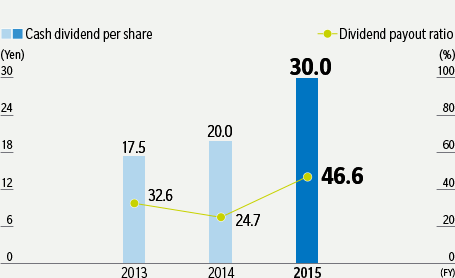
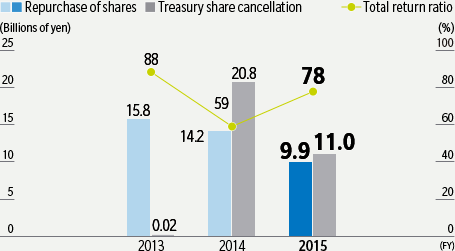
| Phase 1 | Phase 2 | |
|---|---|---|
| Office Services |
|
|
| Commercial and Industrial Printing |
|
|
| Healthcare |
|
|
| Measuring Instruments |
|
|
| Optical Systems |
|
|
| Performance Materials |
|
|
In order to improve business competitiveness, Konica Minolta has been consistently promoting “genre-top” strategies since management integration between Konica and Minolta in 2003. These fundamental strategies remain unchanged, but in addition to them, we are now pressing forward with “business transformation,” an initiative to evolve all of our operations into businesses with high added-value that contribute to resolving customers’ issues.
One major asset of the Konica Minolta Group is its strong direct sales and services network, which has a customer base of two million companies throughout the world. Taking advantage of this huge customer base and engaging in direct dialog with them, we are helping our customers to solve management issues that vary by industry.
We are quickly shifting away from the traditional sales style of building relationships with a specific division, such as the General Affairs Department, towards a “multiple contact-point approach” that encompasses targeting various divisions at customer companies. Some specific examples highlighting how we have transformed our business are shown below for each business area.
First of all, in the office services area of the Business Technologies Business, we consider our customers’ information and content flow as a business process. By automating and optimizing this business process, we resolve a number of operational issues faced by the customer, such as how to improve productivity and enhance security. In this service, digital multi-functional peripherals play a role as a hub on the network and transform customers’ offices into digital workplaces. While the size of the market for offices printing with paper is estimated to be around ¥10 trillion, the ‘digital workflow services’ market enjoys potential demand that outstrips the paper printing market. We regard this business as a driving force in the office services area.
In the area of commercial and industrial printing, we are proposing a shift to ‘on-demand digital’ for commercial printing using paper as the main medium and industrial printing on packages, labels and textiles. In the commercial printing market, of which the size is estimated to be ¥39 trillion globally, digital printing accounts for a mere 3.5%, and it constitutes a meager 2.7% of the global industrial printing market, worth ¥52 trillion in total. However, digital printing has an advantage for small-lot or quick-delivery printing as it does not require plates. Today, an increasing number of printing companies are still introducing digital printers to be used together with offset printers, which are the major production facilities for commercial printing companies. Moreover, digital printing is suited for “printing when needed, where needed and only as much as needed,” and thus helps reduce environmental impact throughout the value chain. From this perspective, latent needs for digitalization are considered extremely high, and I believe that the digitalization of printing will gather momentum worldwide. Through the additional investment in MGI Digital Technology (headquartered in France), which has strengths in digitalization in the label and packaging area, Konica Minolta’s aim is to enhance its competitive edge in the digital printing market.
In the Healthcare Business, we are intensifying our efforts to propose innovative changes in hospital workflows, replacing the use of X-ray film with ‘digital x-ray image diagnosis.’ The “SONIMAGE HS1” ultrasound image diagnosis system Konica Minolta introduced last year has received excellent evaluations from a number of doctors, mainly orthopedic surgeons. We are planning to expand the business, with this system as a strategic product.
In the field of optical systems for industrial use, Konica Minolta provides a system that uses digital technologies to measure the color and light of items such as productions and advertising and sales promotion tools. This enables its customers to conduct unified quality control and brand management beyond regional and national borders, where its digital measurement system ensures the same quality assurance around the globe.
As mentioned above, Konica Minolta will enhance its earning power, by expanding solution proposals in all the business areas that utilize digital workflows tailor-made for different industries and business conditions. In doing so, our aim is to continue improving corporate value indefinitely.
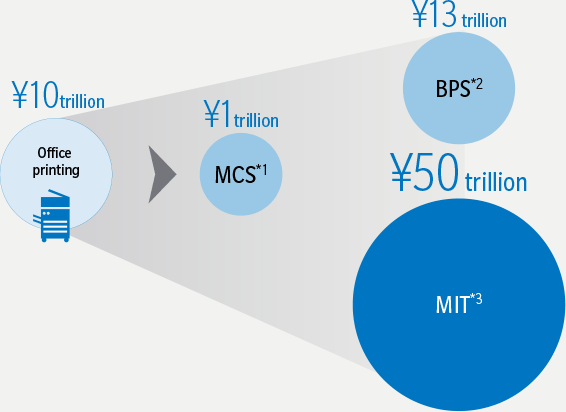
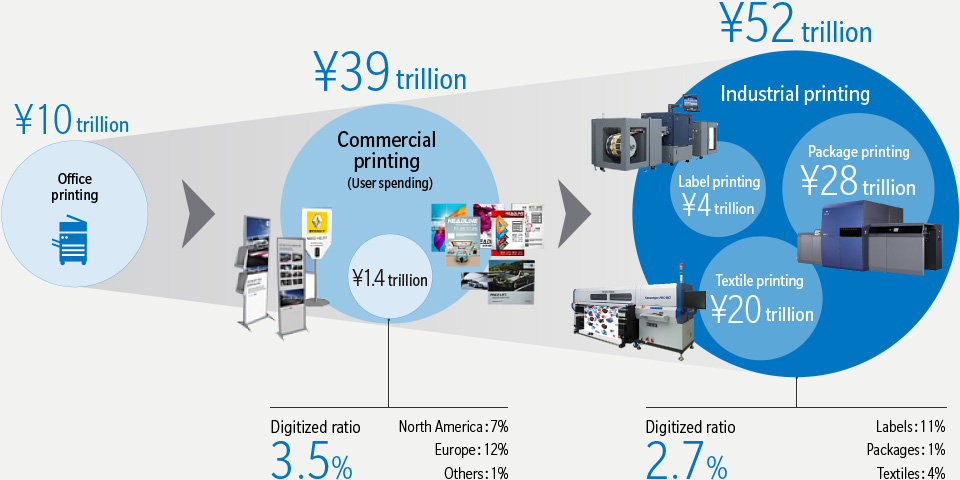
We are also implementing measures for Konica Minolta to achieve sustained growth in the medium- to long-term. One of the most important measures is to utilize ICT—which continues to evolve at a dizzying speed—for management. In particular, I am focusing on three technological areas: namely, “Internet of Things (IoT),” in which everything is connected to the Internet; “artificial intelligence (AI),” centered on deep learning; and “robotics.”
Konica Minolta is pressing forward with a shift in its business focus from “product-out” manufacturing to “market-in” high added-value businesses. The three technologies mentioned above hold the key to creating solution services that match customers’ needs. Analyzing data and images connected by IoT and adding meaning to the analysis enables the creation of various solutions. Konica Minolta’s original “Cyber Physical System” (see pg. 27) is a combination of analytical technologies and input/output devices where the Company excels. I am convinced that this system will lead to business solutions in various areas. In particular, utilizing this system to improve our ability to propose and offer business solutions for departments responsible for marketing and IT budgets, which comprises the bulk of a company’s expenses, we hope that it will be able to drive our sustained growth.
One of the areas where we can take advantage of the system is digital marketing. Many companies previously used mass advertising in their marketing plans. However, that is changing today as they switch to new marketing methods that employ the use of “big data” and target individuals. We have been aware of this trend and already have the ability to offer efficient marketing services for each type of diverse media as the result of our aggressive M&A activities in recent years.
The “One-to-One Marketing” service analyzes various user data and supplies feedback regarding planning customized for individual customers, creating a business that offers high added-value. Konica Minolta’s unique strength lies in its ability to provide “one-stop services,” seamlessly combining digital services and analog sales promotion such as storefront displays and product packaging. By providing these total solutions, our aim is to become a partner who improves our customer’s return on investment and subsequently contributes to enhancing their corporate value.
Additionally, ‘digital manufacturing’ is designed to thoroughly automate manufacturing processes, logistics, warehousing, and administrative and indirect operations, and save labor too. By digitally connecting the entire supply chain from development design to manufacturing, this is initiative aims to prevent loss in all the aspects of operations.
We are also planning to introduce a new service that will automate the appearance testing process, which has heavily relied on human vision until now. By analyzing the data and images captured, the service will be able to help determine the causes of problems, and eventually increase non-defective product rates.
One of the examples of using ICT is the “Care Support Solution” recently launched in Japan. This system uses smartphones as a platform. The combination of multiple technologies, including digital image processing, sensing and voice inputs, on that platform enables the system to watch users at nursing homes. This system is helping to substantially reduce the load on nursing care staff, as overwork is becoming the most serious problem for care providers in Japan.
Our new approaches also include the use of three-dimensional (3D) laser radar. We expect they will be useful in high-security areas, for leak detection at gas plants, the automatic operation of heavy machinery, and behavioral analysis in sports. Not only sold as a new cutting-edge optical sensor component, but also packaged with a video management software (VMS), the products will hopefully help solve issues through the analyses of the data and images captured by the VMS. The main purpose of our acquisition of majority shares in MOBOTIX, a German surveillance camera manufacturer in May 2016, was to obtain the company’s high level of technological prowess in this area.
As mentioned above, we are simultaneously improving our existential value in society and moving towards businesses with high added-value. By doing so, we will accelerate our transformation from a “business-to-business (B2B) company” to a ‘problem-solving digital company’ that reaches the right person, that is to say a “B2B2Person” company.
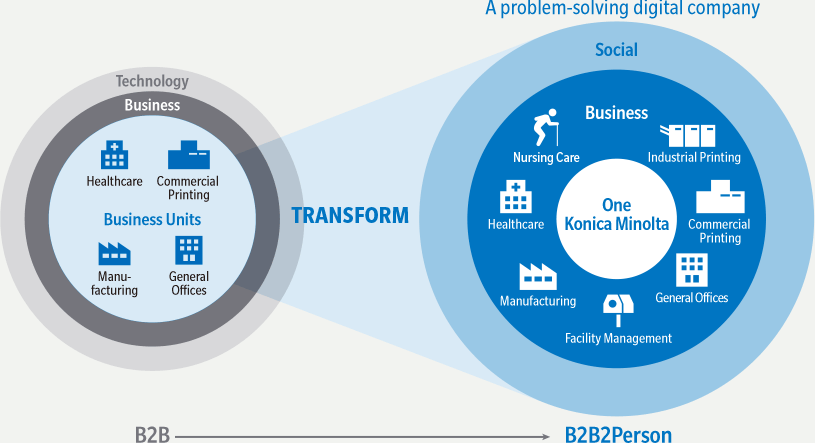
I think that unprecedented innovation is now required for humankind, a type of innovation that inspires one’s fundamental creativity and is essential for improving the quality of society.
Konica Minolta has developed a wide range of technologies since the establishment of the respective founding companies. Integrating the two companies in 2003 gave way to the introduction of an enhanced lineup of technological areas, including optics, sensing, image processing, materials technologies and microfabrication techniques. In 2005, the Company withdrew from its camera and photographic film operations, which had been the mainstay businesses of the two companies since their establishment. Nonetheless, the extensive technologies accumulated were inherited as valuable assets of Konica Minolta and still remain with the Company. We will integrate and evolve these technological assets in the development and proposal of innovative hardware. At the same time, we intend to create solutions for various social issues by incorporating image information and data into diverse platforms, and by analyzing them. These are future growth strategies for the Company. I am sure that we can contribute to realizing a more creative society through such efforts.
Meanwhile, competition continues to intensify in the global market and customers’ needs are becoming increasingly more diversified at a faster pace every year. In order to cope with such situations, we must leave behind the product-out approach and utilize new business innovation to quickly create businesses in the global market that produce real customer value.
Based on these factors, approximately three years ago Konica Minolta set up “Business Innovation Centers (BICs)” (see pg. 33) in five major regions around the world to promote open business incubation. At the BICs, top professionals in the ICT field have been recruited, and are now displaying their significant empowerment in strategic domains. This has made it possible to speed up the development of new services and solutions. As a result, a business ecosystem comprised of burgeoning alliances with start-up companies, universities and corporate partners has formed.
In addition to expanding sales together with profits and non-continuous improvement in productivity, I believe that maximizing cash flows is a vital management issue to contend with in order to drastically strengthen earning power. In order to achieve more efficient and leaner operations, the Konica Minolta Group is carrying out common balance sheet management at all group companies around the world.
For example, in the management of current assets and liabilities, the sizes of receivables and inventories, and the collection periods vary greatly from one company to another within the Group. Therefore, we strive to seek the best suited balance sheet management for each business, such as checking cash conversion cycles (CCCs) for each operation. In addition, not only treated as numbers, CCCs must also be incorporated into specific improvement actions in everyday work as part of an important mission of the employees so that all divisions are working on the initiative.
We are aggressively engaging in the advanced investments required for future growth. At the same time, in addition to streamlining facilities by removing as many assets as possible from the balance sheet, we will continue to sell idle assets. We are also proactively working to remove cross-shareholdings that have little meaning or rationality.
Going forward, we will thoroughly conduct evaluations using net present value (NPV) indicators for investment projects, partly because the accounting standards have changed to international financial reporting standards (IFRS). We will also increase post-acquisition NPV through the pursuit of group synergies in order to avoid incurring impairment losses. It is Konica Minolta policy to use financial leverage appropriately with consideration for management stability. It should be no more than double, even when the Company is stepping up its growth investment.
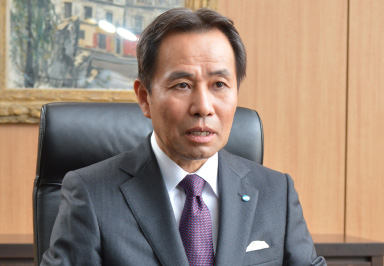
I believe that business growth and contributing to society are exponentially interrelated in business. To clarify, I mean that multiplying a company’s economic activities by its social contribution results in creating new value that serves society in real terms. In order for Konica Minolta to continue growing as a global company, its products and services have to be needed by society and the company’s activities supported by society.
In my fundamental view, I place emphasis on two aspects of a company’s raison d’être in society: namely, contributing to solve global environmental issues and contributing to improving the quality of life for all people. These are both essential for achieving a sustainable and affluent society. With these two points at the core, I believe that Konica Minolta will create new innovative values that motivate and vitalize society, and thereby becoming a company that is vital to society.
The products and services I have mentioned are all solutions that contribute to improving people’s quality of life: the monitoring system that helps resolve issues in the workplace for care services, the healthcare IT system that contributes to preventive care through shared information, and laser radars that contribute to security and safety. We will endeavor to continue developing and offering solutions that help solve various issues faced by society now and in the future.
Regarding global environmental issues, we have set the medium-term target of reducing CO2 emissions by half and are promoting activities that aim to realize more green factories, green products and green marketing. For example, we are using recycled PET bottle materials in the outer packaging materials of our core digital multi-functional peripherals. In addition, the construction of an open recycling system is underway, which includes recycling used milk bottles and turning the materials into toner bottles for printers. Various measures towards reducing environmental impact have been implemented in our production lines, too.
I think that activities to reduce environmental impact and spur economic growth can, and should be simultaneously achieved naturally. For example, reducing CO2 emissions and resource inputs at the time of production can eventually lead to lower total cost and create economic value.
Konica Minolta is also offering environmental impact reduction know-how gained through its own experiences to customers and suppliers. In doing so, and subsequently supporting their environmental management, we are ultimately contributing to environmental preservation; one beyond the scope of our own activities.
One such example is the proposal for digital printing and digital textile printing. On-demand printing anywhere in the world can help to reduce transportation, inventories and wastes, thereby greatly contributing to the global environment.
As the president of a global company, I recognize that my mission is to plan how we wish to be seen by society, and set the direction of business in order to establish ourselves as irreplaceable in the eyes of society. With original technologies at one axis and alliance and cooperation at the other, we will contribute as a corporation and global citizens in order to maintain the global environment, which is vital for all of us from a global and long-term viewpoint, in good health.
Today, all corners of the world are connected by the Internet. In such a ‘connected’ society, creative destruction is occurring in various scenes, with barriers between industries disappearing and new business models emerging. As we shift from a traditional war of scale towards a war of wisdom, companies cannot survive without shedding their familiar coat and aiming to evolve to ever-higher levels.
In order to increase the generation of ideas and connective power required to evolve, a diverse range of human resources is paramount. This includes those who can come up with ideas free from the restrictions of traditional commonsense, and those who are familiar with the cultures and values specific to each region. To this end, the Konica Minolta Group is aggressively recruiting people regardless of nationality or gender, with the ultimate aim of enhancing business competitiveness under our common “6 Values.” As part of this initiative, Richard Taylor, the CEO of a US Business Technologies subsidiary, is the first foreign national to be appointed as an executive officer in the Company. He always speaks frankly, doing so looking on from the position of the customer, and is clearly demonstrating leadership towards our transformation into a customer-oriented company.
Up until now, Konica Minolta has grown by integrating IT services with its existing businesses, creating new products and services with high added-value, and employing new technologies and know-how gained through aggressive M&As. We are currently drawing up a new Medium Term Business Plan that will start in fiscal 2017. The direction of the plan was disclosed in April 2016, but we are hoping to be able to unveil a more detailed outline in the fall of 2016, and the entire picture officially in April 2017.
As a part of the ‘connected’ society, we are committed to continuing our transformation by combining the wisdom and strengths of the Konica Minolta Group in order to grow industries and contribute to the creation of a more affluent world.

Shoei Yamana
President and CEO
Konica Minolta, Inc.